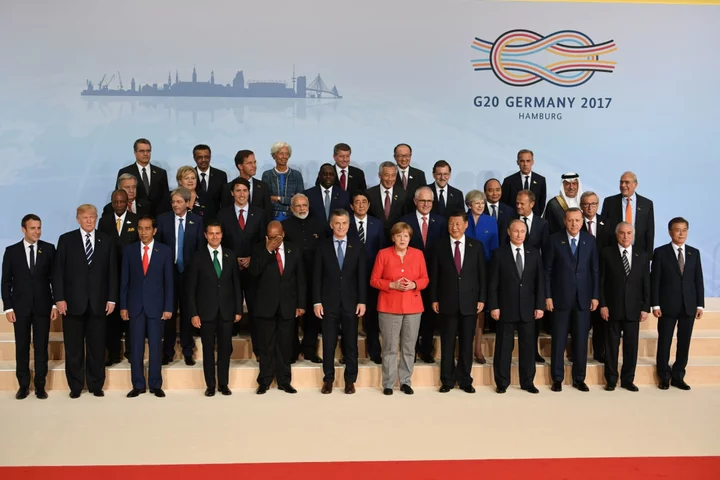The monsoon rains eased as Indian Prime Minister Narendra Modi welcomed world leaders to the Raj Ghat memorial complex in central Delhi on Sunday, site of the eternal flame that burns for Mahatma Gandhi.
Gandhi led the nonviolent protests that brought India independence from British colonial rule in 1947. And Modi’s decision to use the second and final day of his Group of 20 summit to remind his guests of the Father of Nation was another message signaling India’s rise.
Symbolism is hard to escape in the so-called family photograph. It’s a G-20 tradition that offers a rare, unvarnished glimpse of the interaction between leaders — the warmth or chill of greetings, the backslapping, side chats, scowls or moments of awkwardness - and so points to the state of world relations.
Absent from this year’s lineup were China’s President Xi Jinping and Russia’s Vladimir Putin, both of whom skipped the summit amid tensions with the US and its allies. (Mexico’s Andres Manuel Lopez Obrador, who rarely leaves the Americas, also stayed away.)
Indian media reported that the picture would not be a traditional family photo due to disagreement over the inclusion of Foreign Minister Sergei Lavrov, who stood in for Putin.
US-China rivalry and Putin’s war on Ukraine were never far away from the summit and infused the joint statement. But those global challenges took a momentary back seat as leaders ambled toward the black marble monument to Gandhi for their family portrait.
Barefoot walk
Some, like Germany’s Olaf Scholz and Canada’s Justin Trudeau, walked barefoot through the wet. President Joe Biden and Brazil’s Luiz Inacio Lula da Silva — who assumes the G-20 chair from India - were among those wearing slippers or overshoes.
A moment’s silence was held, then traditional Indian music struck up as the G-20 heads made their way out, past a backdrop of Gandhi’s ashram that was a center of the Indian struggle for freedom.
Biden walked beside Modi as the UK’s Rishi Sunak reached over to have a word. Japan’s Fumio Kishida walked beside South Korea’s Yoon Suk Yeol, the recent rapprochement between the two US allies on display. Lavrov, shunned by several leaders, talked with UN Secretary-General Antonio Guterres, who has been pressing for Russia to resume the Black Sea grain deal.
India’s chairmanship of the G-20 was perhaps most notable for securing an unexpected consensus among leaders, in particular on the contentious language related to Russia’s war, but also on global action to combat climate change and on admitting the African Union as a full member of the group.
Here are a few moments captured in recent G-20 summit group photos:
Some leaders are new, others are on their way out, a few veterans have seen it all before. But events always dictate the proceedings. Japan held the last G-20 before the pandemic upended the world. The following year’s summit, hosted by Saudi Arabia, was virtual.
When Argentina hosted the G-20 in 2018, these were happier days for the nation that’s now suffering deep economic turmoil. Argentina — whose president, Alberto Fernandez, isn’t running for re-election so is attending his last summit — has just been admitted to the BRICS grouping as it expands to 11 members from the core of Brazil, Russia, India, China and South Africa.
Germany’s G-20 summit in 2017 was notable for a moment when fellow leaders spontaneously stood up and applauded Angela Merkel, and for the anti-capitalist riots that shook the host city of Hamburg, almost costing the mayor — one Olaf Scholz — his job. Scholz, of course, went on to succeed Merkel as German chancellor.

